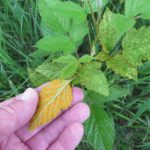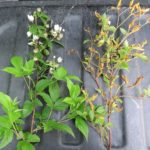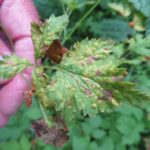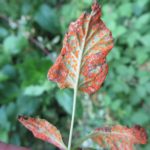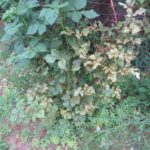Orange rust is one of the most common diseases of blackberries and black raspberries in the Midwest. It is a systemic disease that is confined to Rubus spp. (autoecious). There are two forms, a long-cycle form that occurs on black raspberry, and a short-cycle form that occurs on blackberries. There are two causal organisms: Arthuriomyces peckiamus (the long-cycle form) and Gymnoconia nitens (the short-cycle form). All varieties of black raspberry and many varieties of erect blackberries are susceptible. Red raspberries are immune to orange rust.
Symptoms of the disease can be seen in early spring when new primocanes emerge. Infected plants produce an abundance of spindly canes that have misshapen leaves that are often pale green or yellow. Within a few weeks of emergence, the lower leaf surfaces become covered with blister-like masses of orange aeciospores. This is the most characteristic stage of the disease. Infected plants are quite obvious with brilliant orange leaves. They are showing up now.
The disease cycle of orange rust is complex. Aeciospores from infected canes spread the disease to mature leaves on canes of other plants. Infected leaves develop teliospores later in the summer, which germinate to produce a basidium, which in turn produces basidiospores. The basidiospores infect buds on primocanes at the base of the plants. These infections will spread down through the canes and into the crown, eventually infecting the entire plant. In subsequent years, new canes that emerge from infected crowns will be infected. The fungus persists in the crowns as perennial mycelium.
Damage from orange rust is significant. Even though infected plants seldom die, they are weakened and do not produce quality fruit. Thus they represent a complete loss. That said, heavy infestation of plantings is not common. The disease is usually sporadic. This helps growers manage the spread.
Since orange rust is a systemic fungal disease, management and control is primarily through rouging infected plants. Once infected, a plant cannot be cured. Removing infected plants entirely, including the roots, is the best way to prevent spread. Remove infected plants as soon as they appear in the spring before they release spores. Eradicate infected wild Rubus plants in the near vicinity of your planting. Any management practice that encourages air circulation within the canopy such as thinning canes within the row, removing floricanes immediately after harvest, weed management and proper nutrition will aid in disease control by reducing the duration of leaf wetness. The multiple cycles of infection by the various spore stages make fungicide management very difficult. While a few fungicides are registered for use, chemical control alone is impractical. Proper management is key to controlling orange rust. Fungicide recommendations can be found in the 2017 Midwest Fruit Pest Management Guide. https://ag.purdue.edu/hla/Hort/Pages/sfg_sprayguide.aspx
- Wild blackberry showing normal and infected leaves
- Close up of blister-like pustules on lower leaf surface
- Infected and normal wild blackberries
- Upper surface of black raspberry leaf infected with orange rust
- Lower surface of black raspberry leaf infected with orange rust
- Thornless blackberry plant with a mix of infected and normal canes
- Orange rust spores deposited on a mature leaf
